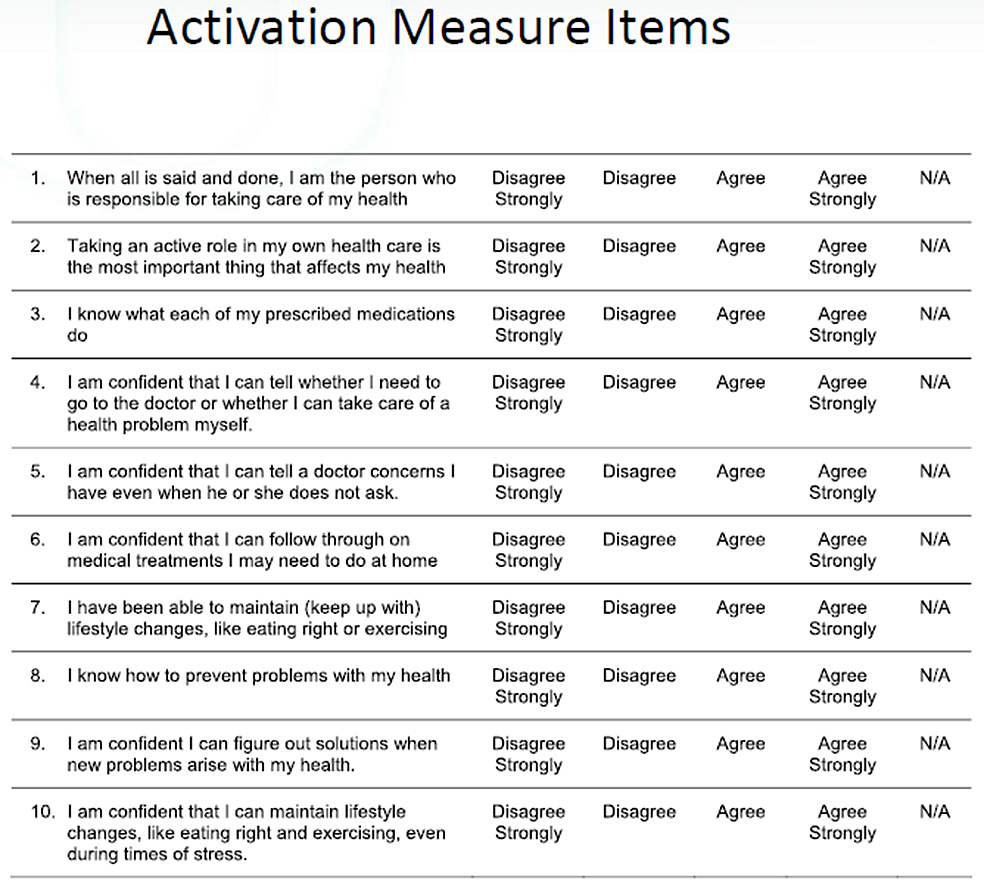Patient Activation Measure (PAM)
A Patient Activation Measure (PAM) is a clinical patient questionnaire which assesses patient knowledge, skill, and confidence for self healthcare management.
- Context:
- It can (typically) be on 0–100 scale.
- It can include Rasch analyses.
- It can be an interval level, unidimensional, Guttman-like measure.
- …
- Example(s):
- a 22-item PAM.
- a 13-item PAM.
- a Patient Activation Measure – Mental Health (PAM-MH), for mental health conditions), such as PAM-MH-13.
- …
- See: Healthcare.
References
2022
- (Wikipedia, 2022) ⇒ https://en.wikipedia.org/wiki/Patient_Activation_Measure Retrieved:2022-9-9.
- The Patient Activation Measure (PAM) is a commercial product which assesses an individual's knowledge, skill, and confidence for managing one's health and healthcare. Individuals who measure high on this assessment typically understand the importance of taking a pro-active role in managing their health and have the skills and confidence to do so.
The PAM survey measures patients on a 0–100 scale and can segment patients into one of four activation levels along an empirically derived continuum. Each activation level reveals insight into an array of health-related characteristics, including attitudes, motivators, behaviors, and outcomes.
- The Patient Activation Measure (PAM) is a commercial product which assesses an individual's knowledge, skill, and confidence for managing one's health and healthcare. Individuals who measure high on this assessment typically understand the importance of taking a pro-active role in managing their health and have the skills and confidence to do so.
2016
- https://www.change4health.org/it-begins-with-you/ibwu-overview/ibwu-patient-activation/
- QUOTE: ... Although there was wide agreement among researchers and health care providers that it was important to engage patients in their own care process, it was not possible at one time to draw conclusions on whether those who were more activated had better health outcomes or lower health care costs. Hibbard (2004) decided to try to develop a tool that would measure patient activation. Ultimately she and her team successfully developed the Patient Activation Measure (PAM). Not only does using it enable researchers to measure health outcomes, but it also gives a provider information on how to customize interventions for their patients. A patient who is less activated in their health may need more information about their condition and treatments. Patients who are more activated may need interventions to increase their skills and confidence. The following figure shows examples of questions that the PAM asks to determine a patient’s activation level.
- Activation Measure Items

Source: Hibbard et al. (2004, August). Development of the Patient Activation Measure (PAM): Conceptualizing and Measuring Activation in Patients and Consumers. Health Serv Res. 39(4 Pt 1): 1005–1026.
- Patient Activation Measure – Mental Health.
A research team led by Carla Green, which included Judith Hibbard, conducted a study to assess whether they could develop a valid and reliable measure of patient activation among individuals with serious mental health problems. The original Patient Activation Measure (PAM) focused on physical conditions and contained items measuring self-assessed knowledge about chronic conditions, beliefs about illness and medical care, and potential for self-care. The new measure, PAM-Mental Health (PAM-MH), adapted the original PAM to assess for mental health-related activation. The revised questions are shown in the figure below.

Source: Green, C. A., Perrin, N. A., Polen, M. R., Leo, M. C., Hibbard, J. H., & Tusler, M. (2010). Development of the Patient Activation Measure for Mental Health (PAM-MH). Administration and Policy in Mental Health, 37(4), 327–333. https://doi.org/10.1007/s10488-009-0239-6
2010
- (Green et al., 2010) ⇒ Carla A. Green, Nancy A. Perrin, Michael R. Polen, Michael C. Leo, Judith H. Hibbard, and Martin Tusler. (2010). “Development of the Patient Activation Measure for Mental Health.” Administration and Policy in Mental Health and Mental Health Services Research 37, no. 4
- ABSTRACT: Our objective was to adapt the physical health Patient Activation Measure (PAM) for use among people with mental health conditions (PAM-MH). Data came from three studies among people with chronic mental health conditions and were combined in Rasch analyses. The PAM-MH’s psychometric properties equal those of the original 13-item PAM. Test–retest reliability and concurrent validity were good, and the PAM-MH showed sensitivity to change. The PAM-MH appears to be a reliable and valid measure of patient activation among individuals with mental health problems. It appears to have potential for use in assessing change in activation.
2005
- (Hibbard et al., 2005) ⇒ Judith H. Hibbard, Eldon R. Mahoney, Jean Stockard, and Martin Tusler. (2005). “Development and Testing of a Short Form of the Patient Activation Measure.” Health services research 40, no. 6
- QUOTE: Objective. The Patient Activation Measure (PAM) is a 22-item measure that assesses patient knowledge, skill, and confidence for self-management. The measure was developed using Rasch analyses and is an interval level, unidimensional, Guttman-like measure. The current analysis is aimed at reducing the number of items in the measure while maintaining adequate precision.
...
Conclusions. The results of the analysis indicate that the shortened 13-item version is both reliable and valid.
- QUOTE: Objective. The Patient Activation Measure (PAM) is a 22-item measure that assesses patient knowledge, skill, and confidence for self-management. The measure was developed using Rasch analyses and is an interval level, unidimensional, Guttman-like measure. The current analysis is aimed at reducing the number of items in the measure while maintaining adequate precision.